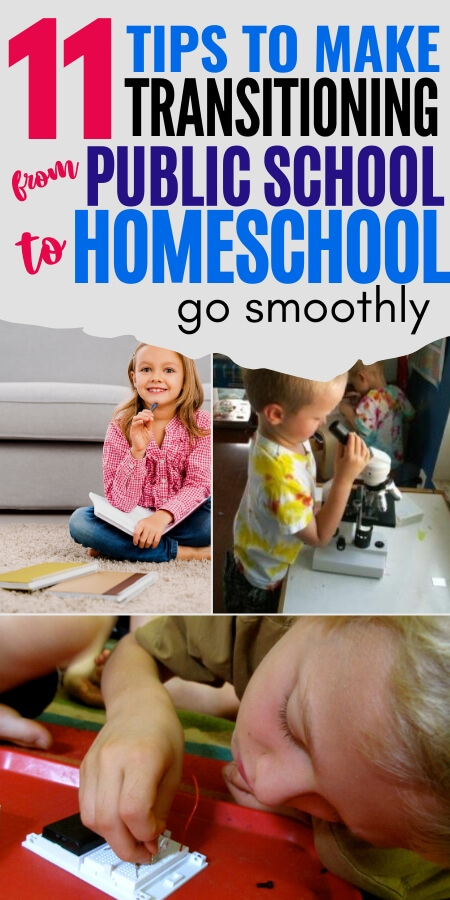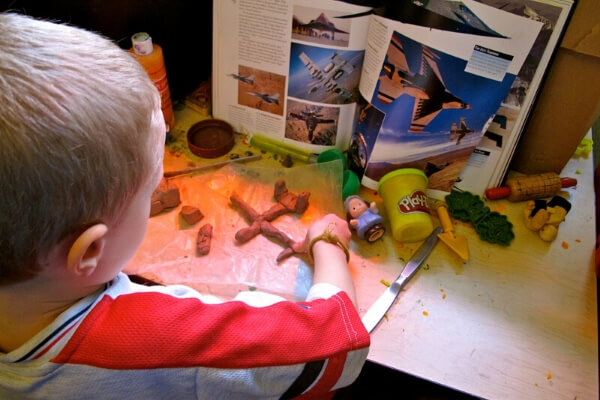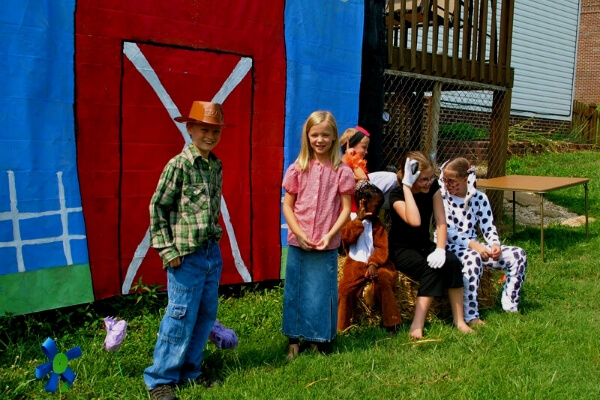Has you child been in public school but will be homeschooled this year? Here are 11 tips to make a smooth transition from public school to homeschool to help reduce stress and make it a great time for everyone in the family!
It’s a big decision to homeschool your children. You probably have tons of questions, concerns, and worries about just about everything when it comes to homeschooling.
** This website contains affiliate links. If you make a purchase using one of these links, I may earn a commission. Please click here for more information about cookies collected and our privacy policy **.
So if you are a new homeschooler, getting ready to start homeschooling this year after your kids have been in public (or private) schools, here are my tips to help make a smooth transition from public school to homeschool.
Even if your kids have never been in school, these tips are great for new homeschoolers who were maybe public schooled themselves.
These are all things I’ve learned over my 14 years of homeschooling- and they will help get you off on the right foot right from the start.

11 Tips to Make a Smooth Transition from Public School to Homeschool
Make it Legal
First and foremost, make sure you know the laws in your state. If you’ve pulled your kids out of public school you need to make sure they are legally being educated so you won’t be accused of truancy.
Every state is different in their requirements, so I can’t tell you exactly what your state will need. But here are some examples of requirements you might come across:
- Teacher’s education: some states are fine with a high school diploma, some require a Bachelor’s Degree
- Notice of Intent: some require this yearly, some once, and some not at all
- Records: Some records you might be required to keep: attendance, grades, vaccinations (here are some free attendance sheets to print!)
- Standardized Tests: Your kids may still be required to take standardized tests either at home or at the local school
- Days: Some states require 180 days of instruction, some 9 months out of the year, some none!
Check out HSLDA’s map to see what your state’s requirements are and make sure they are met before you pull your kids out of school.

Learning about airplanes and jets throughout history and making models of them
Redefine School
This tip is so important. If I had to pick just one, this would be it. Take some time to redefine what school is. “School” is a system, what you want to give your children is an EDUCATION. Those are 2 very different things.
So before jump into homeschooling, throw out all your preconceived definitions and create some new ones. Some things to remember are:
- Education doesn’t have hours. School time and learning can happen at any time.
- Education doesn’t have a place. Again, learning can happen anywhere at any time.
You do not have to recreate public school at home. That’s not the point of homeschooling. You don’t have to have school between 8am-3:30pm. And while we are at it, they certainly don’t need 7-8 hours of school per day.
If you are someone who needs to be told what to do, I’d say follow this guideline:
- Kindergarten: 30 minutes to 1 hour on school book work
- Elementary Grades: 1-2 hours on book work
- Middle School Grades: 2-3 hours on book work
- High School Grades: 4-5 hours on book work
Remember that LIFE is learning. For most homeschoolers there is no division between life and school- and when you really look at it, so much of what you can do in life: cooking, gardening, visiting museums, hiking, raising animals, following passions, etc. can be counted as education.
The school system has hours, classes, recess, lunch times, homework,etc because they HAVE to. Teachers are teaching 30+ kids at a time and class room management is a huge part of the school day. One of one, or one on (however many kids you have) will look much different. And the sooner you realize that, the easier the transition will be.
Take Some Time to De-School
Those preconceived definitions are REALLY hard to get rid of. You’ve likely had an idea in you head of what “school” was since you yourself were a child.
So at the start of the year, take some time to de-school.
What is de-schooling? It’s basically a time to help you and your child decompress from the time in a public school before making the transition to homeschooling. This gives your child, and you, time to rediscover their natural curiosity and reignite their love of learning.
This isn’t like a summer break where they are free to do whatever, but a time of little structure in terms of education. Instead of formal instruction you can use this time to:
- Do art projects
- Learn a handicraft (instrument, knitting, etc)
- Visit the library
- Go to museums
- Visit local historical attractions
- Do lots of nature study and journaling
- Free writing- journals, comics, stories, etc
Basically just get reacquainted with the side of them that loves to learn and explore! This is also a great way to help you redefine what school really is.

Hiking through the Smoky Mountains and identifying natural plants and wild flowers
Give Yourself Time to Adjust
This is a big adjustment- and for most people, it won’t go 100% smoothly.
You might lose your patience. You and your child might fight. And that’s okay.
Eventually things will start to fall into place, but until then, give your kids and yourself grace and time to adjust to this major lifestyle change.
Learn Your Teaching Style
Many time new homeschoolers are so focused on finding just the right curriculum that they forget that there’s more to a great curriculum then what it contains.
Even the BEST curriculum won’t work for you if it doesn’t mesh with your teaching style. So take time time to think about you and how you teach best. Do you hate lecturing or reading aloud? Do you want to be a teacher or a faciliator for your kids’ education?
What are your philosophies when it comes to teaching? Read up on some of the different homeschooling styles and see which one seems to fit best.

Learning about electrical circuits by doing a hands on project to make a light turn on!
Learn Your Child’s Learning Style
Your child’s learning style is also a very important part of homeschooling- and making sure you are speaking to their individual learning style can make your homeschool days go much smoother!
So think about how your child learns best or sit down with your child and talk about how they prefer learn. Do they learn:
- Visually
- Auditory
- Kinesthetically
Do they learn best in groups? Through watching things being done? By reading?
*And note, your teaching style and their learning style may not match, in that case you will have to find a happy medium that works for both of you.
Personalize Your Schedule
Remember, education has no hours. Your school day, week, and year can look however you want it to look.
Your school day doesn’t have to be from 8 am to 3 pm. Got early risers? Start at 6 am if you wish! Kids sleep late? Start after lunch. My oldest son used to do his math lessons at 9pm at night because the house was quietest at that time of night.
Your school week doesn’t have to go Monday through Friday. I have a friend who’s husband works weekends but is off every Tuesday and Wednesday. So they do school on Thursday through Monday and his days off are their weekend. You can do a 4 day week. You can do whatever works best for you.
And your school year doesn’t have to be August through May. You can school year round or take your long break in the winter. When my kids were young we did 4 weeks on, 1 week off all year, with longer breaks (2-3 weeks) at Christmas and summer.
Make a schedule that works for you and your family. And then change it whenever you want- because you have that freedom now!

Homeschooled kids designed sets, rehearsed, and put on a play together!
Find a Support Network
Homeschooling is great, and I wouldn’t educate my children any other way. That being said, it’s hard. And anytime you choose a path that is out of the ordinary it can be hard to find a group of people who understand.
Try and find a couple other homeschool moms or friends who can help you on this journey. You guys can celebrate wins and support each other through tough times.
Find a homeschooling group in your area. These groups will give you other homeschooling parents to talk to, compare notes, talk curriculum, and troubleshoot with. And it will give your kids some friends who are also homeschooled to hang out with.
Get involved in your local homeschool community- but don’t over schedule yourself either!
Don’t Be Afraid to Change Things
One of the beauties of homeschooling is that you can change things that aren’t working. In public school you are stuck with the texts and assignments they give, but as a homeschooler you are allowed to throw out whatever’s not working and exchange it for something that does.
When my oldest was in the 10th grade I bought a beautiful world history curriculum. It looked wonderful- full of literature and projects. And he hated it. I mean HATED it. It was a struggle everyday. So we stopped. Sure I had to swallow the fact that the money was wasted, but my child’s love of learning was more important.
And that’s what’s so great about homeschooling. If an assignment doesn’t work- skip it or tweak it so that it does. If a curriculum is causing problems, try a new one.
Don’t be afraid to change things up mid year.

Dissecting an owl pellet and identifying the bones of small rodents
Include Your Child in the Decisions
Your child’s education is just that THEIRS. They should be included in the decisions.
Get their input on what co-op classes to take. What kinds of sciences they want to cover. What units or projects they want to do.
This is a great time to write out your long term homeschooling goals, and reevaluate what’s important. If your child is obsessed with rabbits and wants to study and create a breeding program for them- let them! Just because it doesn’t follow the scope and sequence of “Life Science for the X Grade” doesn’t mean it’s not a great way to learn science!
Take it One Year at a Time
Just because you decided to homeschool this year, doesn’t mean you have to keep it up for the rest of your child’s educational years.
Things change from year to year. Circumstances change, kid’s needs change, parent’s minds change. And that’s just part of life.
Don’t go into homeschooling telling yourself that you have to homeschool through high school graduation. Just take it one year at a time and if at any point it doesn’t feel right anymore, then make that decision when the time comes.
And finally- have fun! Homeschooling is a great way of life! It’s a life style that embraces natural learning and individuality. Don’t forget to relax and open your mind and just have fun learning and exploring with your kids!


